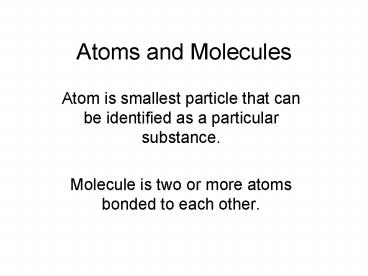Atoms and Molecules - PowerPoint PPT Presentation
Title:
Atoms and Molecules
Description:
Atoms and Molecules Atom is smallest particle that can be identified as a particular substance. Molecule is two or more atoms bonded to each other. – PowerPoint PPT presentation
Number of Views:228
Avg rating:3.0/5.0
Title: Atoms and Molecules
1
Atoms and Molecules
- Atom is smallest particle that can be identified
as a particular substance. - Molecule is two or more atoms bonded to each
other.
2
Elements
- Around 110 different elements have been
identified. Of these around 80 are found in
nature on Earth. - Most common element on Earth is oxygen, symbol O.
- Most common element in universe is hydrogen,
symbol H.
3
Symbols
- Symbols are shorthand for the name of the
element. - Usually first one or two letters of name.
4
Atoms
- Atom is the basic unit of an element. Atoms
contain protons, neutrons, and electrons. - Protons positive charge (1)
- Neutrons neutral, no charge
- Electrons negative charge (-1)
5
Nucleus
- Contains protons and neutrons.
- All positive charge of atom is in nucleus.
- Majority of mass is in nucleus.
- Protons have mass of 1 amu.
- Neutrons have mass of 1 amu.
6
Electrons
- Mass is about 1/2000 of the mass of a proton.
- Electrons orbit the nucleus similarly to planets
orbiting the sun. - All negative charge of the atom is due to
electrons.
7
Charge of the atoms
- Elements have no net charge.
- The number of protons equals the number of
electrons.
8
The Subatomic Particles
- Proton the identity particle. The number of
protons in the nucleus determines which element
the atom is. - Neutrons a neutral particle
- Electrons the personality particle. The
electrons give the atom its characteristic
behaviors.
9
The Symbol Box
- The Atomic Number usually at top of box. Is
the number of protons in the nucleus. - In an element, the atomic number is also the
number of electrons. - The Symbol shorthand for name.
- The Atomic Mass usually at the bottom of box.
Is the sum of the protons and neutrons.
10
Masses
- AMU atomic mass unit. 1.67 x 10-24 g
- Proton and neutron 1 AMU
- Election mass 9.11 x 10-28 g
- Carbon atom mass 12 amu
11
Gain/Loss of Electrons
- Atoms can gain from other atoms or lose electrons
to other atoms. - An atom that loses an electron has a net positive
charge because there are more protons than
electrons. Remember the atom started with equal
numbers of protons and electrons. - An atom that gains an electron has a net negative
charge because there are more electrons than
protons.
12
Ions
- When an atom has lost or gained an electrons it
is called an ion. - Ions with positive charge are known as CATIONS
- Ions with negative charge are known as ANIONS
13
The Periodic Table
- An organized table of all known elements.
- To the left of the stairstep are metals
- To the right of the stairstep are nonmetals
- Along both sides of the stairstep are metalloids.
- Rows are known as periods
- Columns are known as groups
14
Neutrons
- Isotopes
- To be a particular element, an atom must have a
specific number of protons, i.e. 8 protons are in
an oxygen atom. - Most commonly an oxygen atom has 8 neutrons.
Sometimes the nucleus contains has a different
number of neutrons. Isotope is the term for
atoms of a single element that have different
numbers of neutrons.
15
Specifying an Atom
- See paper on symbols on
- www.drbillboyle.com































